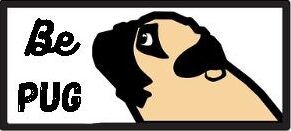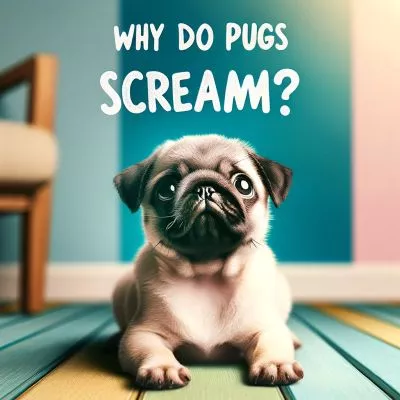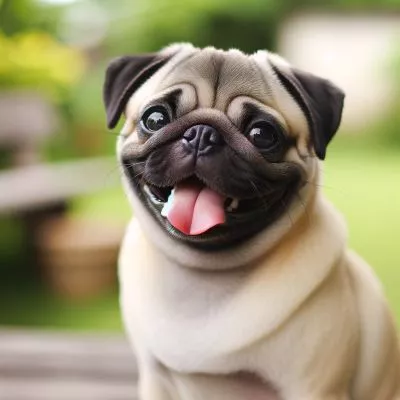The Secret Behind the Snort: Deciphering Why Pugs Make That Unique Sound

Pugs, with their charming, distinctive faces, often exhibit a peculiar snorting sound. This behavior, both curious and endearing to their owners, has its roots in the breed’s unique physical structure. The snorting in pugs arises from their brachycephalic skull shape, which affects their nasal passages and breathing. Understanding this trait involves exploring the anatomy and health implications related to this loveable yet often misunderstood aspect of pug behavior.
I. Introduction to Pug Snorting
A. Overview of Pug Characteristics
Pugs, known for their playful and affectionate demeanor, are a beloved breed worldwide. Characterized by their compact size, expressive faces, and sociable nature, pugs have been cherished as companion animals for centuries. Their unique physical features, such as the wrinkled, short-muzzled face and curled tail, not only contribute to their distinctive appearance but also play a role in some of the breed-specific behaviors and health considerations, including their characteristic snorting.
B. Significance of Snorting in Pugs
The snorting sound commonly heard from pugs is not just a quirky trait but a direct result of their distinct anatomy. While often perceived as endearing, this snorting can be a signal of underlying health issues inherent in the breed. Understanding why pugs snort is crucial for owners to differentiate between normal behavior and potential health concerns that may require veterinary attention.
II. The Anatomy of a Pug
A. Brachycephalic Breed Characteristics
Pugs belong to the brachycephalic breed category, defined by a broad, short skull shape. This distinctive head structure results in a compressed upper respiratory system, which is a defining feature of the breed. The shortened bones in the face and nose lead to a compacted nasal passage and upper respiratory tract, which is largely responsible for the snorting sounds.
B. Impact on Respiratory System
The pug’s brachycephalic anatomy significantly impacts the pug’s respiratory system. The compressed nasal passages and a relatively elongated soft palate can obstruct airflow, making it difficult for the pug to breathe, especially during exercise or in hot weather. This anatomical constraint often leads to the characteristic snorting as the pug attempts to clear these narrowed airways.
C. Relation to Snorting Behavior
Snorting in pugs is primarily a consequence of their effort to inhale sufficient air through the restricted nasal passages. As the demand for air increases during excitement, exercise, or heat exposure, this behavior can be more pronounced. While often considered normal for this breed, owners need to be aware of the anatomical reasons behind this behavior.
III. Health Implications of Snorting in Pugs
A. Common Respiratory Issues
Due to their brachycephalic nature, pugs are prone to a range of respiratory issues. These include brachycephalic obstructive airway syndrome (BOAS), which encompasses conditions such as stenotic nares (narrowed nostrils), elongated soft palate, and everted laryngeal saccules. These issues can lead to difficulty breathing, snoring, and the characteristic snorting sound.
B. Distinguishing Normal vs. Problematic Snorting
While snorting is a common occurrence in pugs, owners must distinguish between normal snorting and signs of respiratory distress. Problematic snorting, which may indicate a more serious condition, is often louder and more frequent and accompanied by other symptoms such as excessive panting, difficulty breathing, or exercise intolerance. In such cases, veterinary consultation is essential.
C. Preventive Care and Management
Effective respiratory health management for pugs involves preventive care and proactive monitoring. Owners should maintain their pugs ‘thy weight, as obesity can exacerbate respiratory problems. Regular veterinary check-ups are crucial to monitor and manage any developing respiratory issues. In some cases, surgical intervention might be necessary to improve airway function.
IV. FAQs
Q: Why do pugs snort?
A: Pugs snort due to their brachycephalic (short-nosed) facial structure, which causes narrowed nasal passages and can lead to breathing difficulties.
Q: Is snorting harmful to pugs?
A: While mild snorting is typical for pugs, excessive or labored snorting may indicate respiratory issues and should be evaluated by a veterinarian.
Q: Can exercise affect a pug’s snorting?
A: Yes, exercise can increase snorting in pugs due to their increased need for air, highlighting the importance of monitoring their activity levels.
Q: How can I help reduce my pug’s snorting?
A: Maintaining a healthy weight and providing a cool, comfortable environment can help minimize snorting. For severe cases, veterinary intervention might be necessary.
Q: Are certain pugs more prone to snorting?
A: Pugs with more pronounced brachycephalic features may experience more snorting, but individual variations exist within the breed.
Q: Does weather affect a pug’s snorting?
A: Yes, hot and humid conditions can exacerbate breathing difficulties in pugs, leading to increased snorting.
Q: Why are my pug’s eyes red?
A: Red eyes in pugs can be caused by various issues, including allergies, infection, or eye conditions like cherry eye. A vet visit is recommended to determine the cause.
Q: How should I clean my pug’s ears?
A: Use a vet-recommended ear cleaner and gently wipe the inside of the ear flap with a cotton ball. Avoid inserting anything deep into the ear canal.
V. Conclusion
A. Summary of Key Points
In conclusion, the characteristic snorting sound is a direct result of their unique brachycephalic anatomy, which impacts their respiratory system. While often normal, owners need to recognize when this behavior might indicate underlying health issues.
B. The Importance of Understanding Pug Health
Understanding why pugs snort is not just about appreciating a breed-specific quirk; it’s a crucial aspect of ensuring the health and well-being of these beloved pets. Recognizing the signs of respiratory distress and providing appropriate care are key to maintaining a happy, healthy pug.
IV. FAQs
Q: Why do pugs snort?
A: Pugs snort due to their brachycephalic (short-nosed) facial structure, which causes narrowed nasal passages and can lead to breathing difficulties.
Q: Is snorting harmful to pugs?
A: While mild snorting is typical for pugs, excessive or labored snorting may indicate respiratory issues and should be evaluated by a veterinarian.
Q: Can exercise affect a pug’spug’sting?
A: Yes, exercise can increase snorting in pugs due to their increased need for air, highlighting the importance of monitoring their activity levels.
Q: How can I help reduce my pug’s snorting?
A: Maintaining a healthy weight and providing a cool, comfortable environment can help minimize snorting. For severe cases, veterinary intervention might be necessary.
Q: Are certain pugs more prone to snorting?
A: Pugs with more pronounced brachycephalic features may experience more snorting, but individual variations exist within the breed.
Q: Does weather affect a pug’spug’sting?
A: Yes, hot and humid conditions can exacerbate breathing difficulties in pugs, leading to increased snorting.
Q: Why are my pug’spug’s red?
A: Pugs’ Various issues, including allergies, infection, or eye conditions like a cherry eye, can cause red eyes. A vet visit is recommended to determine the cause.
Q: How should I clean my pug’spug’s?
A: Use a vet-recommended ear cleaner and gently wipe the inside of the ear flap with a cotton ball. Avoid inserting anything deep into the ear canal.
V. Conclusion
A. Summary of Key Points
This article explored why pugs snort, linking it to their unique brachycephalic anatomy and its impact on their respiratory system. It discussed the normalcy of this trait, how to distinguish between harmless snorting and potential health issues, and the importance of proper care and management.
B. The Importance of Understanding Pug Health
Understanding the reasons behind snorting is crucial for their health and well-being. Recognizing the signs of respiratory distress and ensuring appropriate care is key to maintaining a healthy and happy pug.
VI. Suggested Readings
For pug lovers seeking to deepen their understanding and enhance their care for these charming canines, a well-chosen selection of books can be invaluable. Here are five highly recommended books that every pug owner should consider adding to their library.
- “Pugs” From Pup to Senior” by “Avis – A comprehensive guide covering the lifespan of pugs, challenging common misconceptions, and exploring health, grooming, and training aspects.
- “The “Pug Handbook” by “Emily Wilson – An in-depth look at pug psychology, care, and health, offering practical advice and fresh perspectives on pug ownership.
- “Pugs” A Photographic Journey” by “avid Brown – A visually stunning exploration of pugs, showcasing their beauty and charm through vivid photographs and interesting facts.
- “Pugs” The Ultimate Pug LoverLover’se” by “aura Anderson – An engaging book filled with anecdotes, stories, and photographs, offering a deep dive into the world of pugs.
These books provide valuable insights and detailed information on pugs, from their care and health to their unique characteristics, making them essential reads for pug lovers and owners.






